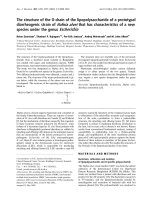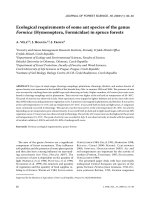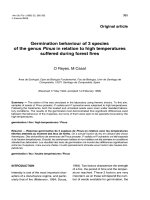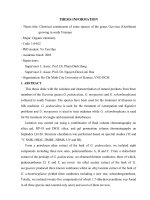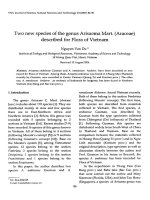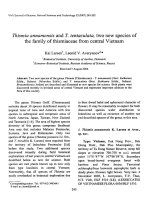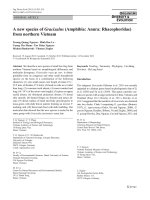NEW SPECIES OF THE GENUS ERIOVIXIA ARCHER FROM BANGLADESH
Bạn đang xem bản rút gọn của tài liệu. Xem và tải ngay bản đầy đủ của tài liệu tại đây (3.54 MB, 10 trang )
Bangladesh J. Zool. 46(1): 1-10, 2018
ISSN: 0304-9027 (print)
2408-8455 (online)
NEW SPECIES OF THE GENUS ERIOVIXIA ARCHER, 1951
(ARANEAE: ARANEIDAE) FROM BANGLADESH
Vivekanand Biswas* and Dinendra Raychaudhuri1
Department of Zoology, Khulna Government Women’s College,
Khulna-9000, Bangladesh
Abstract: A study on the orb-weaving spider genus Eriovixia Archer was carried
out from different areas of Bangladesh. Two species of the genus were recorded of
which one species E. nocturnalis nov. sp. is reported to be new to science and
another one E. laglaizei (Simon) is a new record for the area of present study. The
paper contains generic diagnosis, illustrated description, distribution and key to
the species.
Key words: New species, Orb-weaving spider, Eriovixia, Araneae, Araneidae
INTRODUCTION
Orb-weaving spiders (family Araneidae) are one of the interesting group of
arachnids well known to all due to their peculiar orb-weaving behaviour and
geometric webs. Morphologically, these spiders are very attractive for their
colour and decorated abdomen. Members of the genus Eriovixia Archer are
typical and different among all araneids. These are nocturnal in behaviour and
make large webs within the branches of trees at night.
Member of the genus Eriovixia are commonly known as ‘fallen dry leave
mimicking spiders’ as they fall down on the ground from the webs and stay in
the dry leaves throughout the day showing mimicry. The genus as first irrected
by Archer in 1951 with the type-species Eriovixia rhinura (Pocock 1899). It
contains 21 species worldwide (World Spider catalog 2017) of which 5 spiders in
the Indian Sub-continent (Keswani et al. 2012, Ahmed et al. 2016) and only 1
(one) species in Bangladesh (Okuma et al. 1993, Biswas 2009). To date, the
genus contains 15 species in other Asian countries viz. the Philippines (Barrion
and Litsinger 1995), Japan (Tanikawa 1999, Tso and Tanikawa 2000), China
(Han and Zhu 2010, Mi, et al. 2010, Mi and Wang 2016, Zhou et al. 2017, Zhu
et al. 1994) and Singapore (Koh 1989).
Eriovixia is a small tropical orb-weavers. Berman and Levi (1971) treated the
genus as a synonym of Neoscona Simon, 1864. Later Grasshoff (1986) removed
it from Neoscona and treated it as a valid genus. The genus also resembles
Eustala Simon 1895 in appearance with the presence of caudal elevation or
appendage above and beyond the spinnerets.
*Author of correspondence: <>. 1Entomology laboratory, Department of
Zoology, University of Calcutta, 35, Ballygunge Circular Road, Kolkata-700019, India.
© 2018 Zoological Society of Bangladesh DOI: />
2
Biswas and Raychaudhuri
The present paper contains description of a new species E. nocturnalis nov. sp.
together with report of an earlier described species E. laglaizei (Simon) from
Bagerhat, Bangladesh.
MATERIAL AND METHODS
Collection and preservation: The specimens were collected from the gardens
within and nearer to Govt. P.C. College campus, Bagerhat by vial tapping from
the webs and by hand from the fallen dry leaves, respectively. All the collections
were made early in the morning. Collected specimens were anesthesized with
chlorform in a killing jar and then carried to the laboratory and immediately
transferred them to a Petri dish filled with 70% ethyl alcohol for sorting. Thus,
the specimens were kept for 2 - 3 hours for relaxation of body muscles
(Chowdhury and Nagari 1981). The specimens were then preserved temporarily
in 70% alcohol (single specimen in single vial) for further study.
After study, all the specimens were preserved permanently in ‘Audmans
preservative’ (90 parts 70% alcohol + 5 parts glycerine + 5 parts acitic acid).
Preservation and other necessary techniques were followed by Tikader (1987).
Identification: Identification up to species level and a detailed taxonomic
study of specimens was done based on various fauna volumes and relevant
literatures of the world. The identity of the species was later confirmed from the
Zoological Survey of India, Kolkata.
Illustrations: Illustrations, photographs and other necessary works were done
by Camera lucida and Camera with macro lens fitted with stereo binocular
microscope. Measurements of body parts and legs were taken in millimeters
(mm) with microscopic observations.
Type-deposition: Types of this study are at present in the collection of the
Department of Zoology, Khulna Govt. Women's College and will be preserved at
the Museum of the Department of Zoology, University of Dhaka, in due course of
time.
RESULTS AND DISCUSSION
Family : Araneidae Latreille, 1804
Genus : Eriovixia Archer, 1951
1951.
1971.
1981.
1986.
1989.
Type : E. rhinura (Pocock, 1899)
Eriovixia Archer, Amer. Mus. Novit., 1487 : 18.
Neoscona : Berman and Levi, Bull. Mus. Comp. Zool. Harv. 141: 465.
Neoscona : Tikader and Bal, Rec. Zool. Surv. India, Occ. pap. 24: 1.
Eriovixia : Grasshoff, Ann. Zool. Wetenschappen 250: 118.
Eriovixia : Koh, A guide to Singapor spiders: 36.
New species of the genus Eriovixia
1995. Eriovixia
Asia: 640.
1997. Eriovixia
1997. Eriovixia
1999. Eriovixia
2010. Eriovixia
2012. Eriovixia
2013. Neoscona
2014. Eriovixia
2016. Eriovixia
2017. Eriovixia
3
: Barrion and Litsinger, Riceland spiders of South and SE
:
:
:
:
:
:
:
:
:
Platnick, Advances in Spideer Taxonomy : 500.
Yin et al., Fauna Sinica, Araneidae: 294.
Tanikawa, Acta Arachnol. 48: 41.
Mi et al., Zootaza 2488: 39.
Keswani, Indian J. Arachnol. 1(1) : 14.
Biwas & Raychaudhuri, Rec. Zool. Surv. India 113 (2): 169.
Raychaudhuri & Saha, Atlas Insects & Spiders of BTR : 1.
Ahmed et al., Indian J. Arachnol. 5: 24.
World Spider Catalog, Version 17.O, Nat. Hist. Mus. Bern
(accessed on 07.08.2017).
Diagnosis: Members of the genus Eriovixia Archer are dark in colour with
decorated abdomen. Body elongately oval, with wider abdomen. Carapace pilose
specially the cephalic area. Anterior row of eyes straight; posteromedian eyes
slightly larger than the anterior ones; cephalic region with distinct fovea.
Abdomen sub-triangular, with or without caudal appendage, abdominal tip
elongate, protruded. Legs slender, tibia I longer than carapace. Female larger;
epigunum bears a stout scape with recurved tip, flatter than those in Neoceona.
Tibia of male pedipalps with two long setae and median apophysis projecting
apically.
Biological note: Members of the genus Eriovixia are tropical nocturnal orbweavers. They spain a typical geometric webs at night in which stay in the
middle vertically. If they distdurbed, immediately fall down on the ground and
make place within fallen dry leaves throughout the day. It shows mimicry with
the leaves that they cannot identify. So, they are called ‘fallen dry leave
mimicking spiders.’
They are good predators of insect pests of garden and forests. They consume
numerous insects per day by the webs made by them and so that they are one of
the good biological control agents of pest insects of field crops.
Distribution: Southeast Asia to Africa.
Key to the species
1. Cephalothorax with distinct cervical furrows and rounded
fovea; abdominal dorsum decorated upto long caudal
projection; inner margin of chelicerae with 3 strong teeth (Fig.
1b); anterior margin of sternum nearly straight (Fig. 1d);
epigynum and internal genitalia as in Figs 1e-f
laglaizei
4
-
Biswas and Raychaudhuri
Cephalothorax without cervical
fovea; abdominal dorsum not
chelicerae with 2 pointed teeth
sternum strongly concave (Fig.
genitalia as in Figs. 2e-f
furrows and with elongate
decorated; inner margin of
(Fig. 2b); anterior margin of
2d); epigynum and internal
nocturnalis nov. sp.
1. Eriovixia laglaizei (Simon)
(Figs. 1a-f)
1877. Epeira laglaizei Simon, Ann. Soc. Ent. Fr. 7(5): 77.
1900. Araneus laglaizei : Pocock, Fauna of Brit, India, Arachn.: 224.
1971. Neoscona laglaizei : Berman and Levi, Mus. Comp. Zool. Harv. 141: 465.
1981. Neoscona laglaizei : Tikader and Bal, Rec. Zool. Surv. India, Occ. pap. 24:
27.
1986. Eriovixia laglaizei : Grasshoff, Zool. Wetensch 250: 118.
1994. Neoscona laglaizei : Zhu et al., J. Hevei norm Univ : 25.
1995. Eriovixia laglaizei : Barrion and Litsinger, Riceland spiders of South and
SE Asia: 641.
1997. Eriovixia laglaizei : Yin et al. Fauna Sinica, Arachrida, Araneidae: 298.
1997. Eriovixia laglaizei : Platnick, Advances in Spider Taxonomy: 500
1999. Eriovixia laglaizei : Song et al. The Spiders of China: 287
1999. Eriovixia laglaizei : Tanikawa. Acta Arachnol. 48: 41.
2010. Eriovixia laglaizei : Han & Zhu, J. Nat. Hist. 44: 2609.
2010. Eriovixia laglaizei : Mi et al. Zootaxa 2488: 39.
2012. Eriovixia laglaizei : Keswani et al. Indian J Arachnol. 1(1): 14.
2013. Neoscona laglaizei : Biswas and Raychaudhuri, Rec. Zool. Surv. India,
113(2): 173.
2014. Eriovixia laglaizei : Raychaudhuri and Saha, Atlas of insects and spiders
of BTR: 38.
2017. Eriovixia laglaizei : Zhau et al., Acta Arach. Sinica 26(1): 6.
2017. Eriovixia laglaizei : World Spider Catalog, Version 17.0 Nat. Hist. Mus.
Bern, (accessed on 07.08.2017).
Material examined: 1♀, Chitalmari, Bagerhat, 18.V.1993, Coll. V. Biswas; 2♀,
Jessore, 25.IX. 1993, Coll. V. Biswas; 1♀, Kustia, 18 IV. 1994, Coll. V. Biswas;
1♀, Faridpur, 12.V.1994; Coll. V. Biswas.
General: Cephalothorax yellowish, legs yellowish black; abdomen greyish
yellow. Total body length 8.50 mm. Carapace 3.10 mm long, 2.60 mm wide;
abdomen 6.20 mm long and 4.85 mm wide.
Distribution: Bangladesh: Bagerhat, Jessore, Kushtia and Faridpur, India;
China, Myanmar, Japan, Africa (Tikader and Bal 1981, Han and Zhu 2010, Yin
et al. 1997, Tanikawa 1999, Barrion and Litsinger 1995, Raychaudhuri and
Saha 2014).
New species of the genus Eriovixia
5
Fig. 1a-f. Eriovixia laglaizei (Simon). a. Whole body (dorsal view), b. Chelicerae, c. Maxillae and
Labium, d. Sternum, e. Epigynum, f. Internal genitalia.
6
Biswas and Raychaudhuri
2. Eriovixia nocturnalis nov. sp.
(Figs 2a-f & 3)
Material examined: Holotype : 1♀, Chitalmari, Dist. Bagerhat, 18.IX. 1993;
Coll V. Biswas.
Paratypes: 2♀, otherwise data same as for the holotype. 1♀, Pirojpur, 12.X.
1993. Coll. V. Biswas.
General: Cephalothorax, legs and abdomen light brown; Total body length
(holotype) 18.00 mm. Carapace 6.20 mm long, 5.50 mm wide; abdomen 11.80
mm long and 10.90 mm wide.
Cephalothorax: Longer than wide, posteromedially broad, medially with a
conspecuous long fovea, laterally decorated with blackish markings. Eyes pearly
white, dissimilar, arranged in 2 rows; both rows of eyes recurved; lateral eyes
close, placed marginally; anteromedians situated on the anteriorly narrowed
cephalic region; ocular quad slightly wider anteriorly and narrowing posteriorly;
both anterior and posterior row of eyes procurved (Fig. 2a). Chelicerae brown,
long, parallel sided, strong, each of inner and outer margins with 2 and 4 teeth
(Fig. 2b). Maxillae brown, longer than wide, wider anteromedially, scopulate
anteriorly (Fig. 2c). Labium blackish brown, wider than long, pot-like, scopulate
anteriorily (Fig. 2c). Sternum brown, longer than wide, wide anteriorly and
narrowed posteriorly and bluntly pointed, anterior margin strongly concave (Fig.
2d). Legs long, clothed with spines and hairs; leg formula 1423 and the
measurements (mm) as shown in Table 1.
Male pedipalp light brown with all segments slender, longer than tarsus and
metatarsus; presence of numerous setae all over the segments except trochanter
and femur where less or a few number of setae present.
Abdomen: broad, dark brown, rhomboid, medially wide, poseriorly abruptly
narrowed to form an elongate blunt projection, clothed with fine hairs; Ventrally
light brown in colour from anterior upto the spinnerets. Dorsum without any
hairs or spines.
Spinneret slightly away from the tip of abdomen, light brown, segmented, tip
slightly curved and aggregated together, clothed with small hairs. Epigyne long,
brown, tongue-like (Fig. 2e), directed forward; epigastric furrow curved; internal
genitalic nearly vase-shaped, with enlarge base, copulatory ducts ‘C’ shaped
(Fig. 2f).
Type-locality: Gardens of Bagerhat and Pirojpur districts, Bangladesh, from
the webs made by them.
Etymology: The species is named because of its nocturnal habit.
New species of the genus Eriovixia
7
Figs 2a-f: Eriovixia nocturnalis nov. sp. a. Whole body (dorsal view), b. Chelicerae, c. Maxillae and
Labium, d. Sternum, e. Epigynum, f. Internal genitalia.
8
Biswas and Raychaudhuri
Diagnosis: The new species Eriovixia nocturnalis nov. sp. appears close to E.
laglaizeii (Simon) (Biswas and Raychaudhury 2013) in having rhomboid
abdomen. Contension of proposing it as a new species in because of the district
different characters with above indicated one in the following:
1. Cephalic region anteriorly narrowed.
2. Cervical furrows absent.
3. Elongate forea.
4. Abdomen entirely reticulate, anterior margin nearly straight, lateral hump
absent.
5. Inner margin of chelicerae with 2 teeth.
6. Epigynal scape tongue-like, pointed and internal genitalia vase-shaped (Figs
2e-f).
Therefore, the species is described as new to science.
Fig. 3. Eriovixia nocturnalis nov. sp.
New species of the genus Eriovixia
9
Table 1. Measurements (mm) of leg segments of Eriovixia nocturnalis nov. sp.
Leg
Femur
(mm)
Petella
(mm)
Tibia
(mm)
Metatarsus
(mm)
Tarsus
(mm)
Total
(mm)
I
4.50
1.00
2.50
1.50
0.90
10.40
II
3.00
1.00
1.50
1.20
0.50
7.20
III
0.90
0.20
0.80
0.70
0.30
2.90
IV
3.00
1.20
1.50
1.40
0.60
7.70
Members of the genus Eriovixia are tropical, nocturnal orb-weavers occuring
mainly on the webs vertically. Spiders of this genus are inhabiting in the garden
and forests of Bangladesh. In Indian sub-continent, the genus was first
reported by Pocock (1900) as Araneus laglaizei and till date, only 5 species are
recorded in India and only one species in Bangladesh (Biswas 2009, World
spider catalog 2017). The present study added a new species with another
earlier recorded one in a different locality of the country. As the country is rich
in forest flora and fauna, so as a forest species their number must increase in
future study and will help in identification and conservation practices of the
endangered spider species of the country.
In the present description, both the species are typical in their characters
and identity as stated in the text. Also, they differ in some natural colour and
other morphological characters with the members described in the neighbouring
countries. Therefore, these are very important taxonomically.
Eriovixia species are fallen dry leave mimicking spiders. They stay at the day
in fallen dry rolled leaves dropping from the webs from where they consume
small insects. Thus, they play a great role in the management of garden and
forest insect pests.
Acknowledgements: The authors are grateful to Dr. S.C. Majumder, ScientistSD, Zoological Survey of India, Kolkata, for kind help in confirmation of the
identity of the species and the Head, Department of Zoology, University of
Kolcutta, for kind permission during the course of this study.
LITERATURE CITED
AHMED, J. KHALAP, R. and SUMUKHA, J.N. 2016. A new species of dry foliage mimicking Eviovixia
Archer, 1951 from central western ghats, India (Araneae : Araneidae). Indian J. Arachnol. 5: 2427.
BARRION, A.T. and LITSINGER, J.A. 1995. Riceland spiders of South and Southeast Asia. CAB
International, Wellington, 700p.
BERMAN, J.D. and LEVI, H.W. 1971. The orb-weaver genus Neoscona in North America. Bull. Mus.
Comp. Zool. Harv. 141: 465-500.
10
Biswas and Raychaudhuri
BISWAS, V. 2009. (In Ahmed ed.) Encyclopedia of flora and fauna of Bangladesh, Arachnida, 18(1),
Asiatic Society of Bangladesh, Dhaka, 437 p.
BISWAS, V. and RAYCHAUDHURI, D. 2013. Orb-weaving spiders of Bangladesh: Genus Neoscona
Simon (Araneae : Araneidae). Rec. Zool. Surv. India 113(2): 169-188.
CHOWDHURY, S.H. and NAGARI, S. 1981. Rice-field spiders of Chittagong. Proc. Zool. Soc.
Bangladesh : 53-71.
GRASSHOFF, M. 1986. Die Radnetzspinnen - Gattung Neoscona in Africa (Arachnida : Araneae).
Ann. Zool. Wetenschappen 250: 1-123.
HAN, G.X. and ZHU, M.S. 2010. Taxonomy and biogeography of the spider genus Eriovixia (Araneae :
Araneidae) from Hainan Island, China. J. Nat. Hist. 44: 2609-2635.
KESWANI, S. HADOLE, P. and RAJORIA, A. 2012. Checklist of spiders (Arachnida : Araneae) from
India. Indian J. Arachnol. 1(1): 1-129.
KOH, J.K.H. 1989. A guide to Singapore Spiders. Singapore Science Centre, 160 p.
MI, X.Q. and WANG, C. 2016. First description on the female of Eriovixia huwena and the male of E.
poonaensis (Araneae : Araneidae). Sichuan J. Zool. 35(5): 728-733.
MI, X.Q., PENG, X.J. and YIN, C.M. 2010. The orb-weaving spider genus Eviovixia (Araneidae) in the
Gaoligong mountains, China, Zootaxa 2488: 39-51.
OKUMA. C., KAMAL, N.Q. HIRASDHIMA, Y., ALAM, Z. and OGATA, T. 1993. Illustrated Monograph
of the rice-field spiders of Bangladesh. IPSA-JICA, Gazipur, 93 p.
PLATNICK, N.I 1997. Advances in Spider Taxonomy. American Museum of Natural History, New
York, 630 p.
POCOCK, R.I. 1899. Diagnoses of some new Indian Arachnida. J. Bombay Nat. Hist. Soc. 12: 744753.
POCOCK, R.I. 1900. The Fauna of British India, Arachnida. Today & Tomorows Printers &
Publishers, New Delhi, 279 p.
RAYCHAUDHURI, D. and SAHA, S. 2014. Atlas of Insects and Spiders of Buxa Tiger Reserve. West
Bengal Biodiversity Board and NBI, Kolkata, 357 p.
SONG, D.X., ZHU, M.S. and CHEN, J. 1999. The spiders of China. Hebei Sci. and Tech. Pub. House.
640 p. + 4 plates.
TANIKAWA, A. 1999. Japanese Spiders of the genus Eriovixia (Araneae : Araneida). Acta Arachnol.
Tokyo 48: 41-48.
TIKADER, 1987. Handbook of Indian Spiders. Director, Zoological Survey of India, Kolkata, 287p.
TIKADER, B.K. and BAL, A. 1981. Studies on some orb-weaving spiders of the genus Neoscona
Simon and Araneus Clerck of the family Araneidae (=Argiopidae) from India. Rec. Zool. Surv.
India. Occ. pap. No. 24: 1-60.
TSO, I.M. and TANIKAWA, A. 2000. New records of five orb-web spiders of the genus Leucauge,
Mesida and Eriovixia (Aranea : Tetragnathidae & Araneidae) of Taiwan. Acta Arachnol. 49: 125131.
WORLD SPIDER CATALOG, 2017. World Spider Catalog. version 17.0, Natural History Museum,
Bern (accessed on 07.08.2017).
YIN, C.M. WANG, J. ZHU. M.S., XIE, L.P., PENG, X.J. and BAO, Y. 1997. Fauna Sinica, Arachnida
(Aranae : Araneidae). Science Press, Beijing, 460 p.
ZHOU, H. ZHU, J. and ZHANG, Z.S. 2017. Two new and four newly recorded species of orb-weaver
spiders from China (Araneae : Araneidae). Acta Arach. Sin. 26(1): 6-12.
ZHU, MS, SONG, DX, Zhang, Y.Q. and Wang. X.P. 1994. On some new species and new records of
spiders of the family Araneidae from China. J. Hebei norm. Univ. (Nat. Sci. ed.). 12: 25-52.
(Manuscript received on 2 October, 2017; revised on 25 May, 2018)


